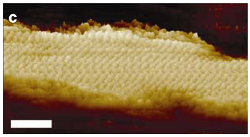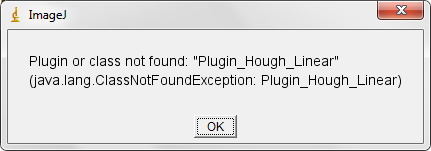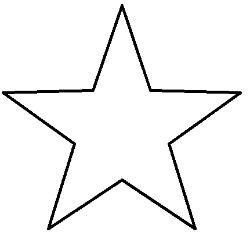measure length of many parallel lines?
measure length of many parallel lines?
|
Hi,
We have images with many more-or-less parallel lines. We can measure the spacing with FFT, but is there a way to measure all their lengths? (and/or the distribution of) Either if there is a function that could do this, or if I could write a plugin/macro? We're looking for a software solution to extract the numbers since measuring them by hand, one at a time, could be subjective (because we know what the theory says), plus there will be many hundreds of them... I've appended an example image, just to give you an idea of what I'm talking about. Others might have several, smaller areas with similar lines (but if need be we could crop them...) Cheers! R 
|
Re: measure length of many parallel lines?
|
Try using a linear Hough Transform to detect the lines. There is one in
ImageJ's plugin library. On Sat, Apr 27, 2013 at 1:18 AM, sombreroduck <[hidden email]>wrote: > Hi, > We have images with many more-or-less parallel lines. We can measure the > spacing with FFT, but is there a way to measure all their lengths? (and/or > the distribution of) Either if there is a function that could do this, or > if > I could write a plugin/macro? > > We're looking for a software solution to extract the numbers since > measuring > them by hand, one at a time, could be subjective (because we know what the > theory says), plus there will be many hundreds of them... > > I've appended an example image, just to give you an idea of what I'm > talking > about. Others might have several, smaller areas with similar lines (but if > need be we could crop them...) > > Cheers! > R > > <http://imagej.1557.x6.nabble.com/file/n5002827/isoPP.png> > > > > -- > View this message in context: > http://imagej.1557.x6.nabble.com/measure-length-of-many-parallel-lines-tp5002827.html > Sent from the ImageJ mailing list archive at Nabble.com. > > -- > ImageJ mailing list: http://imagej.nih.gov/ij/list.html > -- ImageJ mailing list: http://imagej.nih.gov/ij/list.html |
Re: measure length of many parallel lines?
|
Thanks for the tip! I tried downloading it, unpacked to the plugin/analyze folder, but when compiling it always gives me a "plugin or class not found". I've had a bit of a look around the file, but can't see what it's complaining about. Does it require another plugin/macro? there seems to be one called "GHT_", but I can't see any reference to it in the code. On 27 April 2013 15:43, David Webster [via ImageJ] <[hidden email]> wrote: Try using a linear Hough Transform to detect the lines. There is one in |
Re: measure length of many parallel lines?
|
Hi R,
don't unpack anything, just save GHT_.jar into your plugins folder (that's also what is recommended ion the web page of the plugin) For how to use it, see the PDF file. Note that it's not self-explanatory and you have to follow the instructions. If you don't, you will get error messages that are not necessarily saying what is wrong. Michael ________________________________________________________________ On Apr 27, 2013, at 19:38, sombreroduck wrote: > Thanks for the tip! > I tried downloading it, unpacked to the plugin/analyze folder, but when > compiling it always gives me a "plugin or class not found". I've had a bit > of a look around the file, but can't see what it's complaining about. Does > it require another plugin/macro? there seems to be one called "GHT_", but I > can't see any reference to it in the code. > Cheers again! > R > > > On 27 April 2013 15:43, David Webster [via ImageJ] < > [hidden email]> wrote: > >> Try using a linear Hough Transform to detect the lines. There is one in >> ImageJ's plugin library. >> >> >> On Sat, Apr 27, 2013 at 1:18 AM, sombreroduck <[hidden email]<http://user/SendEmail.jtp?type=node&node=5002829&i=0>>wrote: >> >> >>> Hi, >>> We have images with many more-or-less parallel lines. We can measure the >>> spacing with FFT, but is there a way to measure all their lengths? >> (and/or >>> the distribution of) Either if there is a function that could do this, >> or >>> if >>> I could write a plugin/macro? >>> >>> We're looking for a software solution to extract the numbers since >>> measuring >>> them by hand, one at a time, could be subjective (because we know what >> the >>> theory says), plus there will be many hundreds of them... >>> >>> I've appended an example image, just to give you an idea of what I'm >>> talking >>> about. Others might have several, smaller areas with similar lines (but >> if >>> need be we could crop them...) >>> >>> Cheers! >>> R >>> >>> <http://imagej.1557.x6.nabble.com/file/n5002827/isoPP.png> >>> >>> >>> >>> -- >>> View this message in context: >>> >> http://imagej.1557.x6.nabble.com/measure-length-of-many-parallel-lines-tp5002827.html >>> Sent from the ImageJ mailing list archive at Nabble.com. >>> >>> -- >>> ImageJ mailing list: http://imagej.nih.gov/ij/list.html >>> >> >> -- >> ImageJ mailing list: http://imagej.nih.gov/ij/list.html >> >> >> ------------------------------ >> If you reply to this email, your message will be added to the discussion >> below: >> >> http://imagej.1557.x6.nabble.com/measure-length-of-many-parallel-lines-tp5002827p5002829.html >> To unsubscribe from measure length of many parallel lines?, click here< >> . >> NAML<http://imagej.1557.x6.nabble.com/template/NamlServlet.jtp?macro=macro_viewer&id=instant_html%21nabble%3Aemail.naml&base=nabble.naml.namespaces.BasicNamespace-nabble.view.web.template.NabbleNamespace-nabble.view.web.template.NodeNamespace&breadcrumbs=notify_subscribers%21nabble%3Aemail.naml-instant_emails%21nabble%3Aemail.naml-send_instant_email%21nabble%3Aemail.naml> >> > > > > > -- > View this message in context: http://imagej.1557.x6.nabble.com/measure-length-of-many-parallel-lines-tp5002827p5002830.html > Sent from the ImageJ mailing list archive at Nabble.com. > > -- > ImageJ mailing list: http://imagej.nih.gov/ij/list.html -- ImageJ mailing list: http://imagej.nih.gov/ij/list.html |
Re: measure length of many parallel lines?
|
In reply to this post by David Webster
Maybe it's my email, bit I don't see the URL. Do you mean this one from Burger &
Burge? http://www.imagingbook.com/index.php?id=98 That one give me this error 
I've had another look, and still can't see what it doesn't like... |
|
For IJ-PlugIns the first place to look in my opinion is
<http://rsb.info.nih.gov/ij/plugins/index.html> There you will find a link to <http://rsb.info.nih.gov/ij/plugins/ght/index.html> where you can download the PlugIn and read: "Installation: Drag and drop GHT_.jar onto the "ImageJ" window." HTH Herbie __________________________________________ On 29.04.13 11:09, sombreroduck wrote: > Maybe it's my email, bit I don't see the URL. Do you mean this one from > Burger& > Burge? > http://www.imagingbook.com/index.php?id=98 > > That one give me this error > <http://imagej.1557.x6.nabble.com/file/n5002846/linearHT_CompileError.png> > > > David Webster wrote >> Try this website and download chapter 9. I think that this is what I have. >> >> A problem with this approach, and possibly all approaches is the >> subjective difference between one line with gaps and 2 or more parallel >> lines with longitudinal offsets > > > I've had another look, and still can't see what it doesn't like... > > > > > -- > View this message in context: http://imagej.1557.x6.nabble.com/measure-length-of-many-parallel-lines-tp5002827p5002846.html > Sent from the ImageJ mailing list archive at Nabble.com. > > -- > ImageJ mailing list: http://imagej.nih.gov/ij/list.html > -- ImageJ mailing list: http://imagej.nih.gov/ij/list.html |
Re: measure length of many parallel lines?
|
In reply to this post by Michael Schmid
Thanks Michael and Herbie,
The GHT wasn't the one I'd been working with, it was the one from Burger&Burge I mentioned in the post above. I foudn your replies this a.m. and have been trying the GHT for a bit now, and one the +side it runs, but on the - it gives a rather curious output for my test images. I've been using these three (not to scale)    called "reference_object.jpg", "Image1.jpg" and Image2.jpg" resp. The plugin it either finds 0 objects, or anything between 17 and 194. It is probably my choice of parameters, you're right that it isn't intuitive, even with the PDF, but why does it search for the reference object in the image named "reference_object"?! and how can it find it 134 times?! Two parameters I don't understand at all are the Size and Angle delta. Is this merely the difference between the max and min? (in which case why can't it figure that out for itsself?) If I can figure this out, would the GHT be able to detect simple, straight lines too? Cheers! R
|
|
In reply to this post by sombreroduck
It's always a good idea to start with what was stated first in a thread.
Hence, I just had look at the original image in which--I must admit--I can't see any parallel lines but more or less aligned parallel structures (sequences of dots). For me it makes no sense to apply the Hough transform to such images (for an analysis of the elongation of these structures) without heavy preprocessing. In any case, the term "lines" is definitely wrong in the context of the sample image and to realize this fact may lead to more promising approaches to solve your task. HTH Herbie _____________________________________ On 27.04.13 10:18, sombreroduck wrote: > Hi, > We have images with many more-or-less parallel lines. We can measure the > spacing with FFT, but is there a way to measure all their lengths? (and/or > the distribution of) Either if there is a function that could do this, or if > I could write a plugin/macro? > > We're looking for a software solution to extract the numbers since measuring > them by hand, one at a time, could be subjective (because we know what the > theory says), plus there will be many hundreds of them... > > I've appended an example image, just to give you an idea of what I'm talking > about. Others might have several, smaller areas with similar lines (but if > need be we could crop them...) > > Cheers! > R > > <http://imagej.1557.x6.nabble.com/file/n5002827/isoPP.png> > > > > -- > View this message in context: http://imagej.1557.x6.nabble.com/measure-length-of-many-parallel-lines-tp5002827.html > Sent from the ImageJ mailing list archive at Nabble.com. > > -- > ImageJ mailing list: http://imagej.nih.gov/ij/list.html > -- ImageJ mailing list: http://imagej.nih.gov/ij/list.html |
«
Return to ImageJ
|
1 view|%1 views
| Free forum by Nabble | Edit this page |

